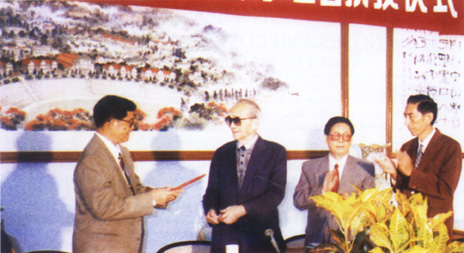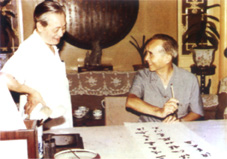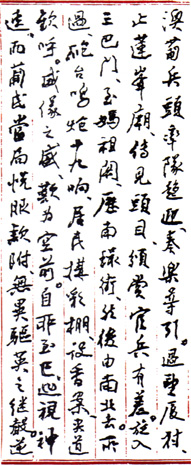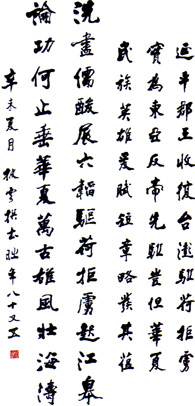§1. BIOGRAPHICAL NOTES
1.1. LIU Lian 柳莲, Liangshi zupu «梁氏族谱» (The Family Tree of the Liang Clan), Meijing 梅镜, Yongchun 永青, 1994, pp. 645-650
1908 (Emperor Guangxu's· reign, year 33)
Piyun, alias Longguang,· also Xueyu,· eldest son, born 2nd February.
At age six starts village school and at age nine enters the town's religious primary school.
1920 (Republic of China (Ming Guo), · year 9)
Studies at the Shengli Shier Zhong· (Provincial Secondary School). Transfers to Jimei Zhongxue· (Jimei Secondary School) six months later.
1921-1922 (Republic of China, years 10 and 11)
Begins writing articles for "Minzhong"· ("The Alarm of the Resident") newspaper in Xiamen. Expelled from Jimei School for participating in Dier ci xuecha · ('Secondary Students' Union Movement').
1923 (Republic of China, year 12)
Admitted to the Yingyu xi· (English Department) of Wuchang Shifan Daxue· (Wuchang Normal University). Transfers to Shanghai Daxue· (Shanghai University) the following year.
1925 (Republic of China, year 14)
Following 'Wusa Can'an'· ('May 30th Massacre') in Shanghai,· sent by Students' Union to undertake propaganda work in Fujian· and Guangdong while auditing at Guangdong Daxue· (Guangdong University) (presently Zhongshan Daxue· (Zhongshan University).
1926 (Republic of China, year 15)
Obtains BA from Shanghai University. Visits Japan twice to pursue postgraduate studies. During second stay, attends Waseda University, majoring in Politics and Economics. Postpones studies because of 'Jiuyiba Shibain'· ('September 18 Incident').
1928 (Republic of China, year 17)
Returns to Xiamen· and becomes editor-inchief of "Mingguo Ribao"· ("Republic Daily"). Writes Shijie shehuiyundong shiluo· (A History of Social Movements of the World), but, due to unsettled life, loses hundred-thousand-word manuscript.
Writes more than a thousand poems between 1928 and 1988.
1929 (Republic of China, year 18)
Encouraged by several distinguished educators of the time, helps to establish Liming Gaozhong· (Liming High School) and elected as Principal.
Writes two couplets on day of Liming High School's inauguration, which are hung on either side of school's entrance gate. The first couplet reads:
"这里不是学校,宇宙才是真正的学校;
我们并没有家庭,学校便是大众的家庭。"
("This is not a school; the Universe is our real school;
We are homeless, and yet the school is home to all of us.")
The second couplet reads:
“少爷气、小姐气、书呆气、流氓气、根本要不得;
平民化、社会化、科学化、艺术化,著手做起来。”
("Do away with princelings and bookworms; We nurture love for the people, society and arts.")
Writes the School motto, placed over its entrance gate:
“奋斗便是生活。”
("To live is to struggle.")
His Liming Xuanyan· (Liming Manifesto) concludes with these lines:
“夜在崩溃,冬在崩溃,黎明在到来,春天在到来,
我们要迎著黎明的光辉,把春天的种子播遍全世界。”
("The night is coming to an end, and so is winter.
Dawn is breaking. Basking in its brilliance, let's sow the seeds of spring all over the world!")
 Liang Piyun 梁披云 being presented with the title of Honorary Professor of the Zhongwen xi 中文系 (Chinese Language Department) of the Haiwai Jiaoyu Xueyuan 海外教育学院 (Foreign Education College) of Xiamen Daxue 厦门大学 (Xiamen University), Fujian province.
Left to right: Lin Zugeng 林祖赓 (chairman of the board), Liang Piyun 梁披云, Zheng Xuemeng 郑学檬 (principal) and Chou Shixing周世雄 Photograph taken in 1995.
Liang Piyun 梁披云 being presented with the title of Honorary Professor of the Zhongwen xi 中文系 (Chinese Language Department) of the Haiwai Jiaoyu Xueyuan 海外教育学院 (Foreign Education College) of Xiamen Daxue 厦门大学 (Xiamen University), Fujian province.
Left to right: Lin Zugeng 林祖赓 (chairman of the board), Liang Piyun 梁披云, Zheng Xuemeng 郑学檬 (principal) and Chou Shixing周世雄 Photograph taken in 1995.
Inspired by the spirit of Liming High School, several progressive schools spring up in Quanzhou, ·turning the city into a prosperous well-known hub of culture and education and attracting many prominent figures, such as Ba Jin,· and even some revolutionaries from Japan, Korea, and Vietnam.
1934 (Republic of China, year 23)
Liming High School forced to close due to political situation.
Piyun receives invitation to teach at Xi'an Xibei Nongxueyuan· (Xi'an Northwest Forestry College), but decides not to accept due to disenchantment with corrupt political situation. Instead, accepts another proposal from an old friend and takes up a teaching post in Malaysia.
While teaching at Zunkong's· Zunkong Zhongxue· (Worship Confucius Secondary School) in Kuala Lumpur, edits Yi Qun Bao· (For the Masses), calling on overseas ethnic Chinese to unite, show love for their motherland and rejuvenate Chinese culture. Activities arouse attention of the local police and moves to Indonesia, where becomes Principal of Sudong Zhongxue· (Sudong Secondary School).
1943 (Republic of China, year 32)
Returns to Fujian. Founds two journals, "Haijiang Xuebao"· ("Newspaper of Haijiang Studies") and "Zhongnan Xuekan"· ("Journal of Middle South Studies").
1944 (Republic of China, year 33)
Becomes Principal of Guoli Fujian Yinyue Zhuanke Xuexiao· (National Music Academy in Fujian).
1947 (Republic of China, year 36)
Appointed Director of Education for Fujian province. Dedicates himself to improving education in the mountain areas and eliminating starvation and illiteracy. Under the leadership of underground communists, gives secret support to progressive student movements and implements strikes by students and teachers at four Fujian universities. Also gives orders to send rice to provide relief to these teachers and students and takes measures to protect many progressives and underground communist party members. Blacklisted by the Guomindang.· Flees to Hong Kong via Xiamen with help from friends and students.
1950 (People's Republic of China)
Invited to become a partner of Hong Kong Nam Kwang Co. Ltd. · and to expand its activities in Singapore, Malaysia and Indonesia.
In the meantime, continues to work in field of education.
1960
While working for "Huaqiao Dao Bao"·("Overseas Chinese Herald") and Jakarta Overseas Chinese Association, riots and persecution of ethnic Chinese sweep through Indonesia. Becomes involved in helping ethnic Chinese settled in Indonesia to return to mainland China.
1961
Returns to China to participate in anniversary celebrations of People's Republic of China. Visits the Great Wall,· Shanhaiguan,· Wuhan Changjiang Bridge, · and other historical sites.
1963
Becomes editor-in-chief in Indonesia of Chinese edition of "Huo Ju Bao" · ("The Torch"), publicising achievements of People's Republic of China.
 Zhao Puchu 赵朴初 appreciating Liang Piyun's 梁披云 calligraphy.
Photograph taken in the mid 1980s.
Zhao Puchu 赵朴初 appreciating Liang Piyun's 梁披云 calligraphy.
Photograph taken in the mid 1980s.
Contributes articles and scores of poems under pen name of Xue Lu.·
1965
'September 30th Incident' gives rise to another orgy of riots against ethnic Chinese in Indonesia. Premises of overseas Chinese associations occupied and "The Torch" office sealed up by military.
1966
Back in China, joins a tour to Yanan.·
In September, settles down in Macao.
1967
Starts making preparations to found the Aomen Guiqiao Zonghui· (Macao Overseas Chinese Association).
1968
In April, Macao Overseas Chinese Association officially inaugurated and Piyun is elected President. Over the years, Association acclaimed as the 'Home of returned overseas Chinese compatriots in Macao'.·
1974
Founds "Shu Pu"· ('Chinese Calligraphy"), Hong Kong bi-monthly periodical devoted to promotion of Chinese calligraphy.
Has large circulation in twenty-odd countries and regions, particularly Japan and United Kingdom, where its impact is felt most strongly amongst students of Chinese calligraphy and language.
1981
Founds Liming Xueyuan· (The Liming Garden of Learning) in Quanzhou, which carries on the fine tradition of Liming Gaozhong· (Liming High School). Elected to Political Consulting Commission of Fujian province and National Consulting Commission of People's Republic of China, to which continues to contribute to this day.
 Transcription by Liang Piyun 梁披云 of a record on Lin Zexu 林则徐 inscribed on a tablet at the rear of his statue, in Lian Feng Miao 莲峰庙 (Lian Feng Temple), in Macao. The calligraphy is dated "September 1989".
Transcription by Liang Piyun 梁披云 of a record on Lin Zexu 林则徐 inscribed on a tablet at the rear of his statue, in Lian Feng Miao 莲峰庙 (Lian Feng Temple), in Macao. The calligraphy is dated "September 1989".
1984
Establishes Liming Daxue· (Liming [Vocational] University), ancillary to the Liming Xueyuan· (Liming Garden of Learning). Compiles Zhongguo shufa da cidian· (A Dictionary of Chinese Calligraphy), consisting of two big volumes with more than thirteen thousand entries, two million, two hundred thousand ideograms, and two thousand, five hundred illustrations.
Presented a gold medal by the authorities of Fujian province with the inscription: "Leyu yingcai"· ("Most Distinguished Educator").
1987
In October, Liming University formally established and is elected Chairman of the Board.
1989
In January, is invited to participate in Liang Piyun deng wu ren shufa zhuanke zhanlan· (Liang Piyun and Others: An Exhibition of Calligraphy) exhibition in Singapore.
In the autumn, Liming University celebrates sixtieth anniversary of his educational career with thematic seminars, publications, etc.
1990
In April, founds Fujian Xuexiao· (Fujian School in Macao), aimed at providing education for children of natives of Fujian. Emphasises that purpose of school is to train "[...] good, intelligent, aspiring and disciplined personnel for Macao."
1992
The Xuelu shigao· (Collection of Calligraphic Manuscripts of Xuelu' Poems) is published by the Aomen Wenhua Sishu· (Cultural Institute of Macao). It consists of three parts: Menghen xinying ji· (Pursuing My Dreams and Ideals: 1928-1949), Yinghai xiao ge ji· (Singing Over the Seas: 1950-1966) and Qiu hong zui zao ji· (Trailings of a Wild Goose: 1966-1988). The book starts with a Xu (Preface) by the renowned Singapore poet and calligrapher, Pan Shou. · The famous Chinese poet and calligrapher, Zhao Puchu· sends the following message of congratulations on the day of the Collection's launch:
“弥钦爱国至忱,更佩雅人深致,
中心藏之,何日忘之。”
("I'm full of admiration for your profound patriotism;
I'm struck with awe by your refined poems.
All this will be buried in my heart;
And in my heart it will last.")
Exhibition entitled Liang Piyun shiyi shuhua zhan· (Liang Piyun's Works of Poetry and Calligraphy) organised by Liming University, Yongchun county, Huaqiao Daxue· (Huaqiao University), and others. Exhibition travels to Quanzhou, · Guangzhou,· Yongqing,· and elsewhere.
1993
In June, Aomen guiqiao zonghui he Aomen meishujia xiehui· (Liang Piyun's Works of Poetry and Calligraphy) exhibition, co-sponsored by Macao Overseas Chinese Association and the Aomen Meishujia Xiehui· (Macao Artists' Association),· is held in the Territory and draws large audience.
1.2. PENGLAI Xin Zi 蓬莱新姿, Aiguo ai sangzi, fayang hao chuantong «爱国爱桑梓。发扬好传统。» (Love for one's Country: Love for one's Hometown — the Liangs Carry on the Fine Family Tradition), 1994, Liming Daxue 黎明大学 Liming University, pp. 4-10.
1.3. QIN Huiyu 秦惠玉, Jiafeng yu yingcai «家风育英才» (Fine Family Traditions have nurtured generations of outstanding talents), in "Liming Daxue Xuebao" "黎明大学学报 "Liming University Journal", (1) 1992.
[...]
§2. COMMENTS ON LIANG PIYUN'S WORKS BY HIS CONTEMPORARIES
2.1. PAN Shou 潘受, Xu «序» (Preface), in "Xuelu shigao" "雪庐诗稿" ("A Collection of Calligraphic Manuscripts of Xuelu's Poems"), Aomen 澳门 Macao, Aomen Wenhua Sishu 澳门文化司署出版 Cultural Institute of Macao, 1991, pp. 1-5.
"Poetry is imbued with feeling. A poem without feeling, like a flower without aroma or a fruit without juice, is a bad poem, or can not be called a poem at all.
One cannot be a poet without learning, just as trees will not blossom or bear fruits without sunshine. Without knowledge, one cannot see through things, and the lines have nothing to offer, to advise, or to warn.
[...].
Poetry becomes touching and stirring when filled with sincerity. It becomes elucidating when filled with profound truth. Sincerity is beauty. Truth is life.
Sincerity and truth are illuminating.
Literature is the study of man and the highest form of human expression.
Where there is man there is poetry. Poetry inspires. Poetry feels. Poetry unites. Poetry talks. Poetry cries. Poetry reveals the poet.
Mastering poetry is like commanding armies; it is the quality that counts.
A single line may become an immortal poetic sentence, handed down generation by generation, no one begrudging its shortness.
This is my personal understanding of the nature of poetry. And this can be applied to the poetry of my old friend, Liang Piyun. Piyun came to Singapore with three volumes of his poetry written between 1928 and 1988. He asked me to comment on his poetry. How could I? I simply would not dare, being so much younger than him!"

A 'siyan qijueju' 四言七绝句 ('four lines seven characters') poem written by Liang Piyun 梁披云 in the summer of 1993.
The three twelve ideograms' long lines (on the right) state the poet's reasons which led him to write the poem. The two fourteen ideograms' long lines (on the left) are the poem as such.
2.2. JI Xianlin 季羡林, Liming Daxue Dongshihui 黎明大学董事会 (Liming University Board), ed., Xu «序»(Preface), in "Xuelu shigao""雪庐诗稿"("Xuelu Shigao"), Guonei ban 国內版 Mainland Edition, 1993, pp. 2-3.
"I have never been good at writing poetry, but I have been a great reader. I have confidence in my own capacity to comprehend poetry. As for literary criticism, I am well-versed in 'the ways of the world'.
At around the age of thirty, I wandered round Europe for ten odd years. During the last five decades, since my return to China, I have nurtured the desire to become a teacher at Bei Da· [Beijing University]. During these fifty years, I have also travelled to more than twenty countries in Asia, Africa and Europe. I have met all sorts of people, seen a lot and heard a lot. I have experienced all the political movements and campaigns in China; I have been through all the ups and downs, turns and twists, storms and tempests, in short, through all the vicissitudes of life. Now, in my late eighties, I am sure I know all the ways of the world and experienced almost everything. A Song dynasty [960-1279] poem reads:
“悲欢离合总无情,
一任他阶前点滴到天明。”
("Happy reunions, sad partings, there is no sense!
Let them go on, just in the doorway, until dawn.")
This scene, which may have looked so remote in the past, seems so real now. But let bygones be bygones and forget. But there is one thing that I cannot forget. Some years ago, through Ms. Liu Yuelian and Mr. Huang Xiaofeng, I had the opportunity to meet Mr. Liang Xueyu in Beijing. What a pleasant surprise! Allow me to use a 'romantic' expression and say that we 'fell for each other at first sight'. Indeed we immediately felt like old friends at our very first encounter. It makes life more worthwhile to have known such a noble character as Liang Xueyu.
It is a great pity that Xuelu shigao· (A Collection of Calligraphic Manuscripts of Xuelu' Poems) has not been published in mainland China because so few people will have access to the Macao edition. Ah, I have just received a call from Yuelian, telling me that the Xuelu shigao is to be published in mainland China, soon. Great news!"
2.3. LIULIAN 柳莲, ed., Xuelu shigao youhao zhihan shijian shicui «雪庐诗稿友 好致函诗笺拾萃» (A Collection of Poems Congratulating Peiyun on the Publication of His Xuelu Shigao), in "Aomen Xiezuo Xuekan" "澳门写作学刊 ("Macau Writers' Journal"), Aomen 澳门 Macao, (4-5) 1993, pp. 68-70.
The contributing poets are: Liu Yisheng,· Chen Ludi, · Mo Zhongzi, · Chen Yongzheng,· Ren Jiyu,· Cheng Guangyu,· Zhao Puchu,· Shi Zhecun,· Wu Baitao· and Mao Yibo. ·
2.4. A letter sent by Sha Menghai,· in 1989.
2.5. YANG Kuizhang 杨圭章, Danxin yipian, haoqi zongheng, du Liang Piyun xiansheng — Xuelu shigao «丹心一片,豪气纵横—读梁披云先生<雪庐诗稿>» ["red inflamed heart, magnificent wondering spirit", in Xuelu shigao by Liang Piyun] (Comments), in "Aomen Xiezuo Xuekan" "澳门写作学刊" ("Macau Writers' Journal"), Aomen 澳门 Macao, (2-3) 1993.
2.6. WANG Jiangshui 王江水, Lun Liang Piyun guanyu siben aiben guben de changdao «论梁披云关于“思本、爱本、固本”的倡导» [Liang Piyun's proposal to meditate, love and strenghten one's origins] (Comments), in "Liming Daxue Xuebao" "黎明大学学报" Liming University Journal", (1) 199 2.
2.7. ZHANG Mali 张玛莉, Liang Piyun zhi zuo bu zuanqian de shengyi «梁披云只做不赚钱的生意»[Liang Piyun only makes non-profit business] (Comments), in "Penglai Xinzi" "蓬莱新姿" "Penglai Xinzi", pp. 128-129.
Extracts translated from the Chinese by: Ieong Sao Leng, Sylvia 杨秀玲 Yang Xiuling
* Professor Emeritus of Xiamen Daxue· (Xiamen University) and Vice-Chairman of the Board of Huaqiao Daxue· (Huaqiao University). Professor Emeritus of Xiamen Daxue· (Xiamen University) and Vice-Chairman of the Board of Huaqiao Daxue· (Huaqiao University). Honorary President of Liming Daxue· (Liming University). President of the Aomen Guiqiao Zonghui· (Macao Overseas Chinese Association), delegate of the Quanguo Zhengxie· (National Consulting Commission of the People's Republic of China), consultant to the Zhongguo Dongfang Wenhua Yanjiuhui· (International Confucius Learning Society and National Institute of Oriental Culture), and advisor to the Quanguo Guiguo Huaqiao Lianhehui· (All-China Overseas Chinese Association).
start p. 251
end p.